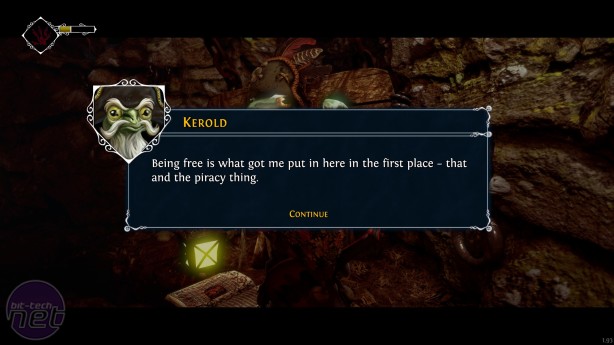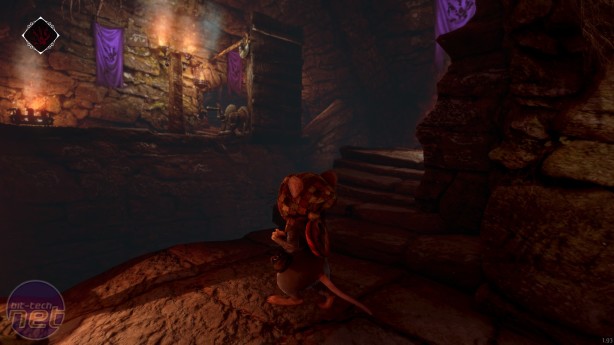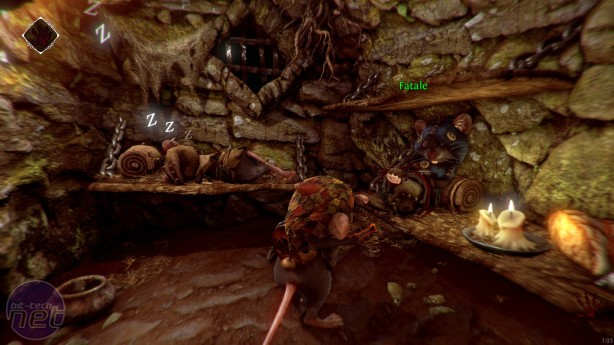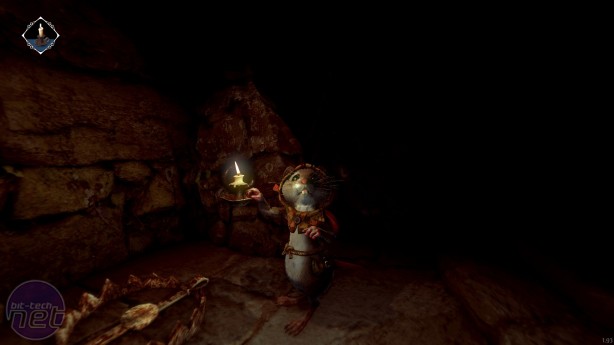
Again, the animations sell the stealth brilliantly. Tilo brings his paws up to his chest and tiptoes when he sneaks, and switches to all-fours when he runs. But as a system, the stealth sorely lacks depth. For starters, you can’t hide in shadows, which is always going to be a problem for a stealth game, as it means you’re too often exposed and can’t create your own hiding places by extinguishing light sources. Meanwhile, the emphasis on fixed hiding places means you can’t be all that creative when evading guards, as you’re often forced to return to the same places over and over.
For a stealth game to be engaging, it needs to actively involve the player; to be about more than waiting for enemies to move into the right position so you can slip past them. Ghost of a Tale offers a few tools for you to achieve this. Sticks can be thrown to distract guards and grease pots can cause them to slip, temporarily stunning them. But these things are fiddly to say the least and the cramped corridors which make up a large amount of Dwindling Heights mean there isn’t an awful lot of room to use these tools effectively. Like Frozenbyte’s Shadwen, Ghost of a Tale’s stealth is too static and simplistic to be that much fun.
Compounding this problem is the fact that the game forces you to constantly backtrack through the same areas on quests that ultimately amount to glorified treasure hunts. Quests in Ghost of a Tale are essentially, 'collect these items and bring them back to me.' You’ll also discover costumes that lend Tilo special abilities, but completing a set also involves more collecting, which in itself requires more backtracking. The game mitigates some of this backtracking through shortcuts which can be discovered through exploration, but this doesn’t alter the fact that sneaking past the same guards in the same way is dull.
That said, discovering those shortcuts in the first place is fun. Ghost of a Tale undeniably has a hint of that Dark Souls magic of gradually mastering a 3D environment, uncovering its secrets and learning all of its nooks and crannies. Alongside the incredible art, it bolsters that sense of place through some fantastic writing. Characters such as the Old Pirate Frog speak in witty, riddling nonsense strongly reminiscent of Alice in Wonderland. For example, when you offer to help set the pirate free from his cell, he responds with, 'Free! Why would I want to be free? Being free is what got me put here in the first place!' All the characters are drawn from similar moulds, and encountering one is always a great little reward after skulking through a particularly niggly stealth section.
It’s a tough one to judge. The stealth in Ghost of a Tale is important for adding that sense of peril to the adventure, but I also feel it gets in the way of the game’s better elements – exploring its beautiful fantasy castle, solving its tactile puzzles, interacting with its warm and funny characters. Fortunately, there’s still plenty time to smooth out the creases. Currently only about 25 percent of the game is explorable, meaning there’s a much larger world in the works.
That means there’s also time to make the stealth slicker, faster and more open-ended, as it needs to be to prevent it from being a drudge between the fun bits. If Seith can get the stealth to click into place, to make it feel like one game rather than two games awkwardly stitched together, I’ve no doubt Ghost of a Tale will prove to be something quite special.
For a stealth game to be engaging, it needs to actively involve the player; to be about more than waiting for enemies to move into the right position so you can slip past them. Ghost of a Tale offers a few tools for you to achieve this. Sticks can be thrown to distract guards and grease pots can cause them to slip, temporarily stunning them. But these things are fiddly to say the least and the cramped corridors which make up a large amount of Dwindling Heights mean there isn’t an awful lot of room to use these tools effectively. Like Frozenbyte’s Shadwen, Ghost of a Tale’s stealth is too static and simplistic to be that much fun.
Compounding this problem is the fact that the game forces you to constantly backtrack through the same areas on quests that ultimately amount to glorified treasure hunts. Quests in Ghost of a Tale are essentially, 'collect these items and bring them back to me.' You’ll also discover costumes that lend Tilo special abilities, but completing a set also involves more collecting, which in itself requires more backtracking. The game mitigates some of this backtracking through shortcuts which can be discovered through exploration, but this doesn’t alter the fact that sneaking past the same guards in the same way is dull.
That said, discovering those shortcuts in the first place is fun. Ghost of a Tale undeniably has a hint of that Dark Souls magic of gradually mastering a 3D environment, uncovering its secrets and learning all of its nooks and crannies. Alongside the incredible art, it bolsters that sense of place through some fantastic writing. Characters such as the Old Pirate Frog speak in witty, riddling nonsense strongly reminiscent of Alice in Wonderland. For example, when you offer to help set the pirate free from his cell, he responds with, 'Free! Why would I want to be free? Being free is what got me put here in the first place!' All the characters are drawn from similar moulds, and encountering one is always a great little reward after skulking through a particularly niggly stealth section.
It’s a tough one to judge. The stealth in Ghost of a Tale is important for adding that sense of peril to the adventure, but I also feel it gets in the way of the game’s better elements – exploring its beautiful fantasy castle, solving its tactile puzzles, interacting with its warm and funny characters. Fortunately, there’s still plenty time to smooth out the creases. Currently only about 25 percent of the game is explorable, meaning there’s a much larger world in the works.
That means there’s also time to make the stealth slicker, faster and more open-ended, as it needs to be to prevent it from being a drudge between the fun bits. If Seith can get the stealth to click into place, to make it feel like one game rather than two games awkwardly stitched together, I’ve no doubt Ghost of a Tale will prove to be something quite special.

MSI MPG Velox 100R Chassis Review
October 14 2021 | 15:04













Want to comment? Please log in.